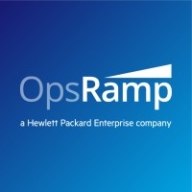

InfluxDB and OpsRamp are competing in monitoring and infrastructure management. InfluxDB takes a lead in real-time analytics and time-series data, whereas OpsRamp excels in comprehensive infrastructure management.
Features: InfluxDB provides scalable architecture, efficient handling of time-series data, and fast query capabilities. OpsRamp offers extensive automation tools, comprehensive dashboarding, and robust incident management features.
Room for Improvement: InfluxDB could enhance its dashboard capabilities, expand its use case scenarios, and improve its incident management integration. OpsRamp might better streamline its complexity, reduce its steep learning curve, and add more focused analytics features.
Ease of Deployment and Customer Service: InfluxDB offers straightforward deployment with minimal configuration needs. OpsRamp involves a more detailed setup, but provides dedicated support options ensuring effective management.
Pricing and ROI: InfluxDB is cost-effective for businesses prioritizing time-series data, delivering good ROI for such needs. OpsRamp might have higher initial costs, but offers a significant long-term ROI with its extensive management capabilities.
| Product | Market Share (%) |
|---|---|
| OpsRamp | 2.7% |
| InfluxDB | 0.6% |
| Other | 96.7% |


| Company Size | Count |
|---|---|
| Small Business | 4 |
| Midsize Enterprise | 3 |
| Large Enterprise | 6 |
| Company Size | Count |
|---|---|
| Small Business | 1 |
| Midsize Enterprise | 3 |
| Large Enterprise | 8 |
InfluxDB is open-source software that helps developers and enterprises alike to collect, store, process, and visualize time series data and to build next-generation applications. InfluxDB provides monitoring and insight on IoT, application, system, container, and infrastructure quickly and easily without complexities or compromises in scale, speed, or productivity.
InfluxDB has become a popular insight system for unified metrics and events enabling the most demanding SLAs. InfluxDB is used in just about every type of industry across a wide range of use cases, including network monitoring, IoT monitoring, industrial IoT, and infrastructure and application monitoring.
InfluxDB offers its users:
InfluxDB Benefits
There are several benefits to using InfluxDB . Some of the biggest advantages the solution offers include:
Reviews from Real Users
InfluxDB stands out among its competitors for a number of reasons. Two major ones are its flexible integration options and its data aggregation feature.
Shalauddin Ahamad S., a software engineer at a tech services company, notes, “The most valuable features are aggregating the data and the integration with Grafana for monitoring.”
OpsRamp is a leading cloud-based digital IT operations management platform. The solution allows your organization to leverage hybrid observability, process automation, and machine learning to modernize IT operations. OpsRamp can handle the speed, scope, and scale of modern IT and can help you drive productivity and business value. In addition, it can help your business manage, monitor, and consolidate your point tools and applications.
OpsRamp Features
OpsRamp has many valuable key features. Some of the most useful ones include:
OpsRamp Benefits
There are many benefits to implementing OpsRamp. Some of the biggest advantages the solution offers include:
We monitor all IT Infrastructure Monitoring reviews to prevent fraudulent reviews and keep review quality high. We do not post reviews by company employees or direct competitors. We validate each review for authenticity via cross-reference with LinkedIn, and personal follow-up with the reviewer when necessary.